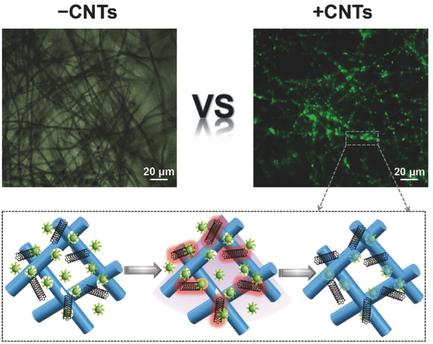Our official English website, www.x-mol.net, welcomes your
feedback! (Note: you will need to create a separate account there.)
Porous Electrospun Fibers with Self‐Sealing Functionality: An Enabling Strategy for Trapping Biomacromolecules
Small ( IF 13.0 ) Pub Date : 2017-11-02 , DOI: 10.1002/smll.201701949 Jin Zhang 1, 2 , Ting Zheng 2 , Emine Alarçin 2 , Batzaya Byambaa 2 , Xiaofei Guan 2 , Jianxun Ding 3 , Yu Shrike Zhang 2 , Zhongming Li 1
Small ( IF 13.0 ) Pub Date : 2017-11-02 , DOI: 10.1002/smll.201701949 Jin Zhang 1, 2 , Ting Zheng 2 , Emine Alarçin 2 , Batzaya Byambaa 2 , Xiaofei Guan 2 , Jianxun Ding 3 , Yu Shrike Zhang 2 , Zhongming Li 1
Affiliation

|
Stimuli‐responsive porous polymer materials have promising biomedical application due to their ability to trap and release biomacromolecules. In this work, a class of highly porous electrospun fibers is designed using polylactide as the polymer matrix and poly(ethylene oxide) as a porogen. Carbon nanotubes (CNTs) with different concentrations are further impregnated onto the fibers to achieve self‐sealing functionality induced by photothermal conversion upon light irradiation. The fibers with 0.4 mg mL−1 of CNTs exhibit the optimum encapsulation efficiency of model biomacromolecules such as dextran, bovine serum albumin, and nucleic acids, although their photothermal conversion ability is slightly lower than the fibers with 0.8 mg mL−1 of CNTs. Interestingly, reversible reopening of the surface pores is accomplished with the degradation of PLA, affording a further possibility for sustained release of biomacromolecules after encapsulation. Effects of CNT loading on fiber morphology, structure, thermal/mechanical properties, degradation, and cell viability are also investigated. This novel class of porous electrospun fibers with self‐sealing capability has great potential to serve as an enabling strategy for trapping/release of biomacromolecules with promising applications in, for example, preventing inflammatory diseases by scavenging cytokines from interstitial body fluids.
中文翻译:

具有自密封功能的多孔电纺纤维:捕获生物大分子的启用策略
刺激响应性多孔聚合物材料由于其捕获和释放生物大分子的能力而具有广阔的生物医学应用前景。在这项工作中,设计了一类高度多孔的电纺纤维,使用聚丙交酯作为聚合物基体和聚环氧乙烷作为致孔剂。不同浓度的碳纳米管(CNT)进一步浸渍到纤维上,以在光照射下通过光热转换实现自密封功能。碳纳米管含量为0.4 mg·mL -1的纤维对葡聚糖、牛血清白蛋白、核酸等模型生物大分子具有最佳的包封效率,但其光热转换能力略低于碳纳米管含量为0.8 mg·mL -1的纤维。有趣的是,表面孔隙的可逆重新打开是通过PLA的降解来实现的,这为封装后生物大分子的持续释放提供了进一步的可能性。还研究了 CNT 负载对纤维形态、结构、热/机械性能、降解和细胞活力的影响。这种具有自密封能力的新型多孔电纺纤维具有作为捕获/释放生物大分子的有利策略的巨大潜力,在例如通过清除间质体液中的细胞因子来预防炎症性疾病方面具有广阔的应用前景。
更新日期:2017-11-02
中文翻译:

具有自密封功能的多孔电纺纤维:捕获生物大分子的启用策略
刺激响应性多孔聚合物材料由于其捕获和释放生物大分子的能力而具有广阔的生物医学应用前景。在这项工作中,设计了一类高度多孔的电纺纤维,使用聚丙交酯作为聚合物基体和聚环氧乙烷作为致孔剂。不同浓度的碳纳米管(CNT)进一步浸渍到纤维上,以在光照射下通过光热转换实现自密封功能。碳纳米管含量为0.4 mg·mL -1的纤维对葡聚糖、牛血清白蛋白、核酸等模型生物大分子具有最佳的包封效率,但其光热转换能力略低于碳纳米管含量为0.8 mg·mL -1的纤维。有趣的是,表面孔隙的可逆重新打开是通过PLA的降解来实现的,这为封装后生物大分子的持续释放提供了进一步的可能性。还研究了 CNT 负载对纤维形态、结构、热/机械性能、降解和细胞活力的影响。这种具有自密封能力的新型多孔电纺纤维具有作为捕获/释放生物大分子的有利策略的巨大潜力,在例如通过清除间质体液中的细胞因子来预防炎症性疾病方面具有广阔的应用前景。











































 京公网安备 11010802027423号
京公网安备 11010802027423号